
Martonvásár
Beethoven in the park
Rain date: Monday, 22 June
RAIN DAY RULES AND INFORMATION
250th anniversary of the birth of the composer For more than 60 years in the town of Martonvásár, the Hungarian National Philharmonic Orchestra’s concert series Beethoven in the Park has provided an unrivalled classical music experience for the summer season.
This year’s event – the 62nd – promises to be a truly special occasion. We will pay tribute to the 250th birthday of the Viennese maestro as part of Martonvásár’s Beethoven Anniversary Year programmes. On this celebratory occasion, the audience will enjoy the composer’s remarkable works across five nights, instead of the usual three.
And with the help of some prestigious Hungarian solo performers, all nine of Beethoven’s symphonies will be performed in Brunswick Castle’s beautiful park. The conductor for the concerts will be Zsolt Hamar, the musical director of the Hungarian National Philharmonic Orchestra.
Composed in Heiligenstadt in 1801 and 1802, the Symphony No. 2 is one of the final works of Beethoven’s first period. No mark was left on the tone of this symphony that, while still Classical in terms of it scope, was nevertheless chock full of suprising rhythmic and melodic gestures, by the fact that Beethoven became aware of the incurable deterioration of his hearing while writing it. The composer’s intimate Romance in G major for violin and orchestra also dates from around this time. Although it was composed later than its F-major counterpart, it was published earlier, thus becoming the first of the two. Beethoven’s Symphony No. 7 dates from 1811/12. Praised as „the apotheosis of dance” by Richard Wagner, it is indeed dance-like in character throughout, with the dotted rhythm of the 6/8 opening movement followed by, instead of a slow movement, an almost sacred dance in 2/4 time identified as an Allegretto. This movement is the most popular part of the symphony, and had to be repeated at the world première. After the rapid scherzo, the fourth movement closes the work with a bacchanalian finale.



